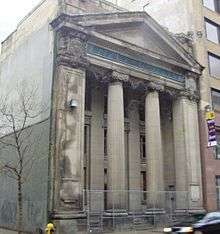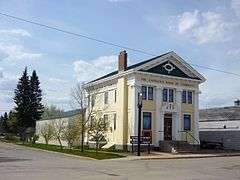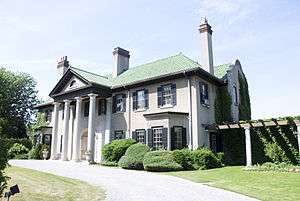Pearson and Darling
Pearson and Darling was an architectural firm based in Toronto from 1897 through 1923, a key player in shaping the urban look of the city and the rest of Canada in the first half of the 20th century.
Formation
The firm was organized first as Darling, Curry, Sproatt, & Pearson in 1892, with partners Frank Darling, S. George Curry, Henry Sproatt, and John A. Pearson. From 1893 through 1896 it evolved into Darling, Sproatt & Pearson, then finally Pearson and Darling was founded as such in 1897.
Its heyday began with Darling's commissions from the Canadian Bank of Commerce in 1898, grand Beaux-Arts buildings in Toronto, Winnipeg, Montreal, and Vancouver, and dozens of smaller branches in smaller Canadian cities and towns. Darling's training with the English architect George Edmund Street in the early 1870s brought a serious, substantial, Victorian influence, well-suited to large civic and institutional projects in the years of the nation's development.
Their subsequent projects included the first tall steel-frame building in Canada (the Royal Tower in Winnipeg, 1904), the tallest building in Canada for three decades (the 1930 Canadian Bank of Commerce Building in Toronto), and the largest single building in the British Commonwealth (the Sun Life Building, Montreal, 1931).
Legacy
After the deaths of Frank Darling in 1923 and Pearson in 1940, the firm was renamed Darling, Pearson and Cleveland with Darling's nephew as a partner. The firm continued as Clark, Darling and Downey Architects Incorporated in 1977.[1] The firm lives on now as Toronto-based Stanford Downey Architects Incorporated.[2]
Pearson and Darling
- Alpha Delta Phi Toronto Chapter House, 1894. Originally known as the Ince house
- University of Toronto Faculty of Law, Flavelle House, 1901
- Union Bank Building, 500 Main Street, Winnipeg, with the George A. Fuller Co., 1904
- 197 Yonge Street, Toronto, 1905 - renovated former banking building
- Canadian Bank of Commerce, Watson, Saskatchewan, 1906
- Convocation Hall, University of Toronto, 1906
- Moose Jaw Court House, Moose Jaw, Saskatchewan 1908
- Old Canadian Bank of Commerce Building, Montreal, 1906–09
- University of Toronto Sanford Fleming Building and Sigmund Samuel Building, 1907, and additions to the latter in 1912

- The Church of St. Mary Magdalene, 1908
- Grain Exchange Building - 167 Lombard Street, Winnipeg, 1906-1908
- Toronto General Hospital, College Wing, now the MaRS Discovery District building, 1911
- Canadian Pacific Building, Toronto, for a time the tallest building in Canada, 1913
- One King Street West, Toronto, 1914
- Royal Ontario Museum original building (west wing), 1914
- Parkwood Estate, 1916
- North Toronto railway station of the Canadian Pacific Railway 1916
- Art Gallery of Ontario original building, 1916
- MaRS Discovery District - old Toronto General Hospital College Street wing - 101 College Street, Toronto, 1919
- Varsity Arena, Toronto, 1926
- Private Patients Pavilion (Thomas J. Bell Wing), Toronto General Hospital, 1930
- Canadian Bank of Commerce Building building in Toronto; now Commerce Court North, 1930
Darling, Pearson and Cleveland
- Sun Life Building, Montreal, 1931
- expansions to the Art Gallery of Ontario, 1935
- Complexe Desjardins, Montreal, 1976
Images
-

197 Yonge Street, Toronto
-
Summerhill-North Toronto CPR Station, its 140-foot clock tower modelled on the Campanile di San Marco in Venice
-

Convocation Hall, Toronto
-

Sun Life Building, Montreal
-

original Royal Ontario Museum Building, Toronto, photo circa 1930
-

Toronto General Hospital, College Wing
-

Canadian Bank of Commerce
Watson, Saskatchewan -
Flavelle House, home of the University of Toronto's Faculty of Law, Toronto
-

AGO original wing, Toronto
-
Varsity Arena roof behind Varsity Centre seating, Toronto
-
Complexe Desjardins, Montreal
-
One King Street West, Toronto
-

Parkwood Estate, Oshawa
-

Union Bank of Canada on the left, in Winnipeg, Manitoba
References
- ↑ http://www.raic.org/raic/college_of_fellows/2008fellows.pdf
- ↑ "Our History". Stanforddowney.ca. Retrieved 2012-08-15.